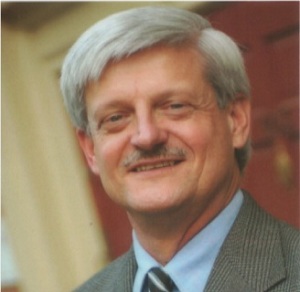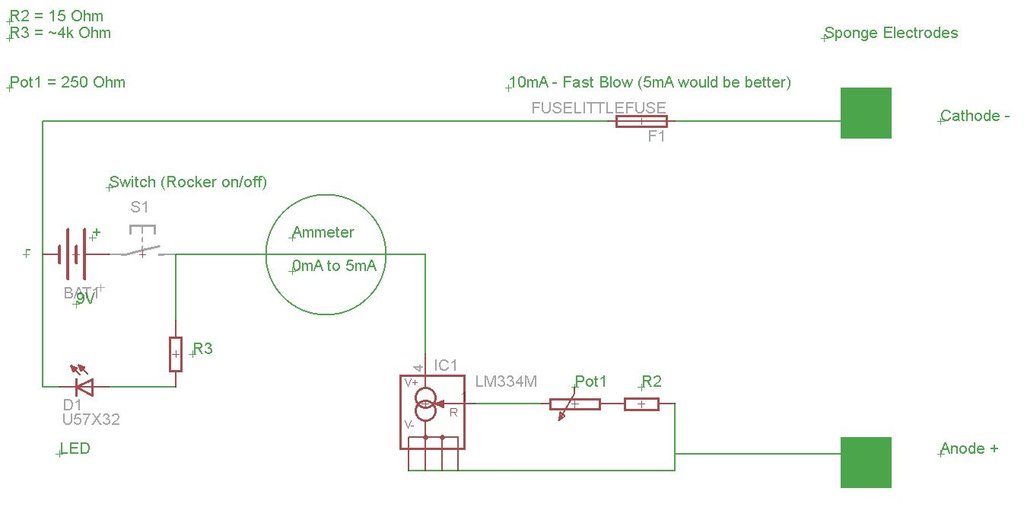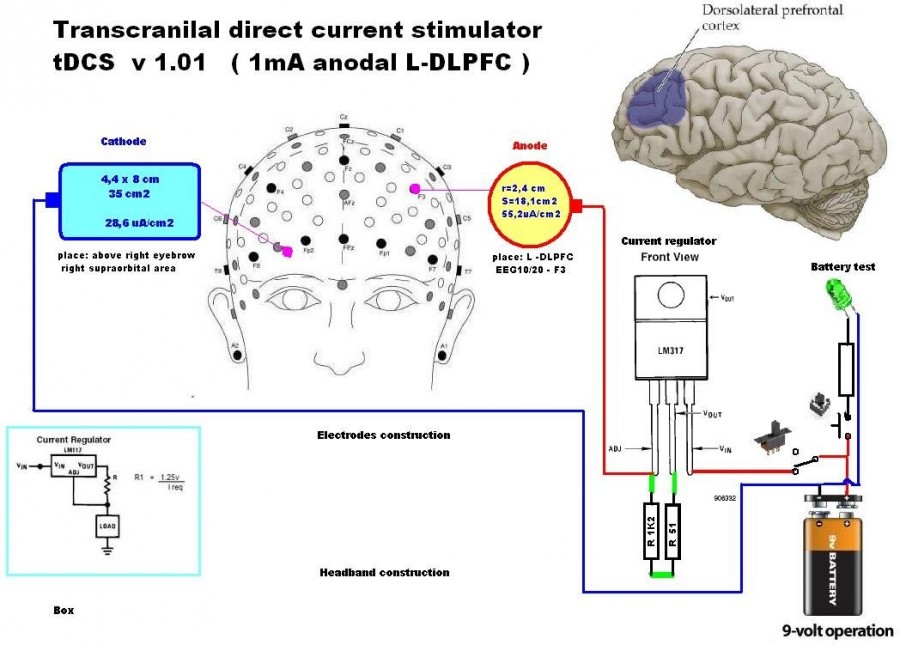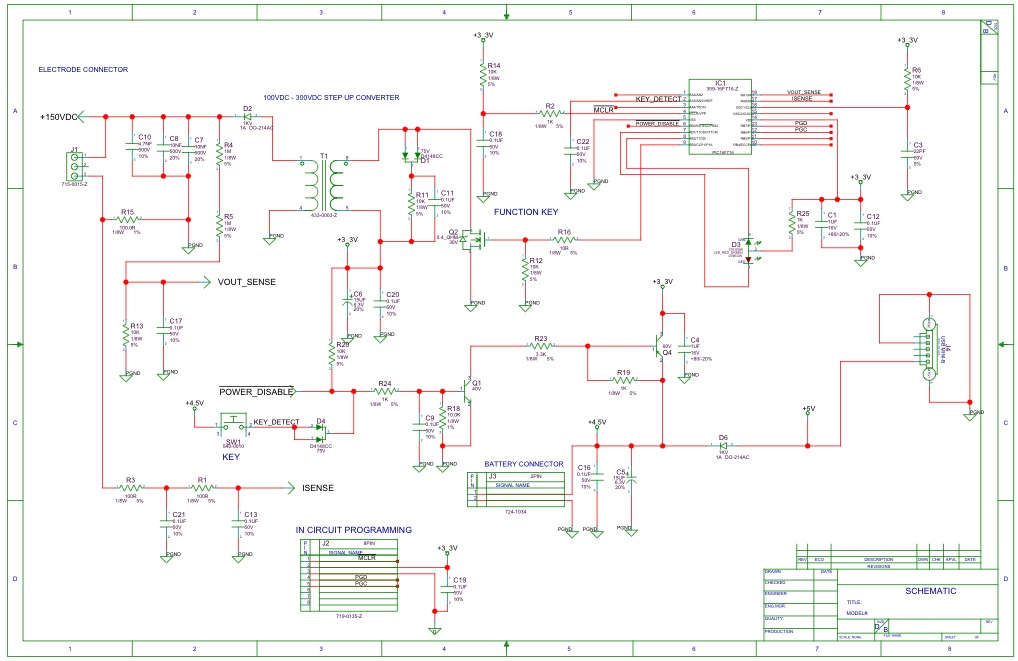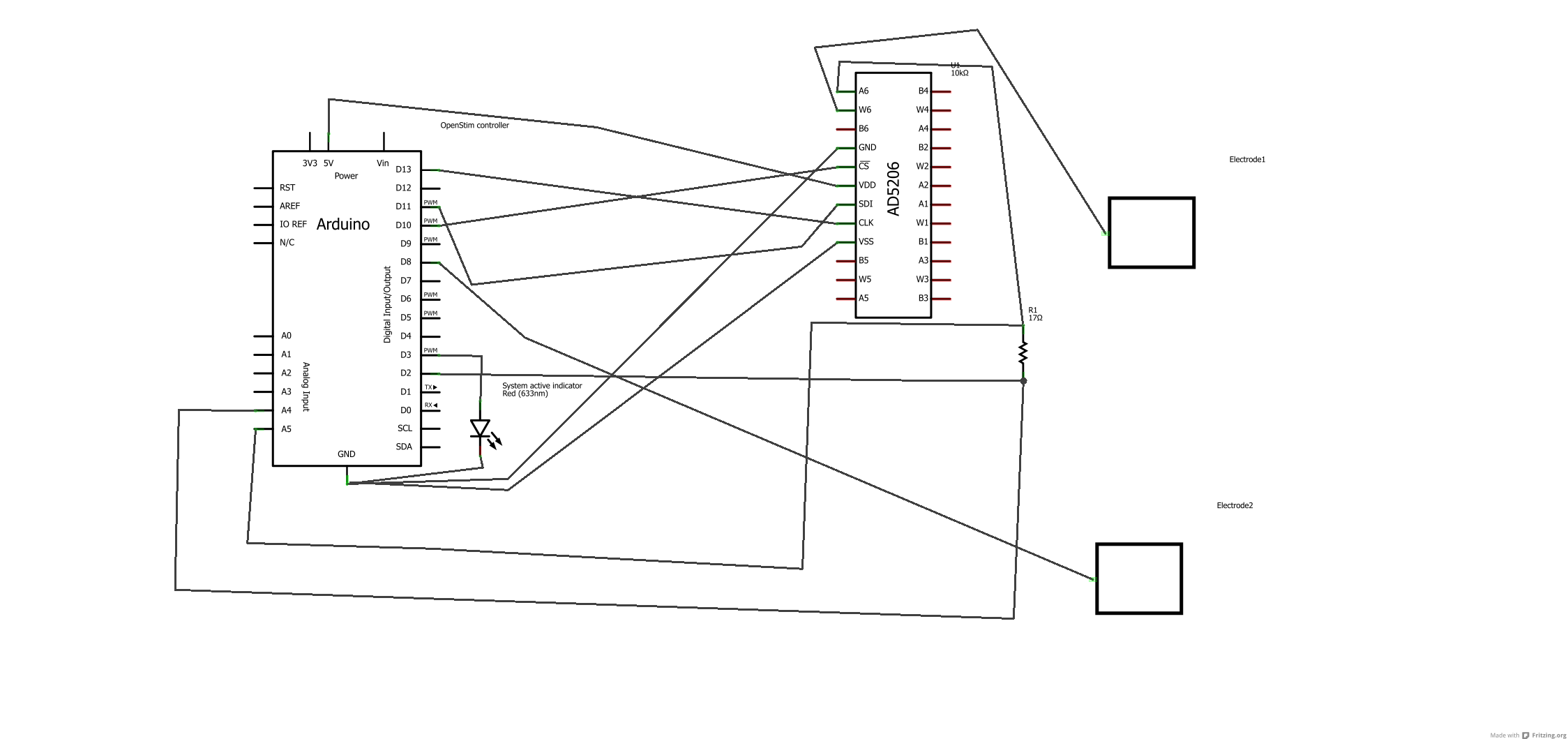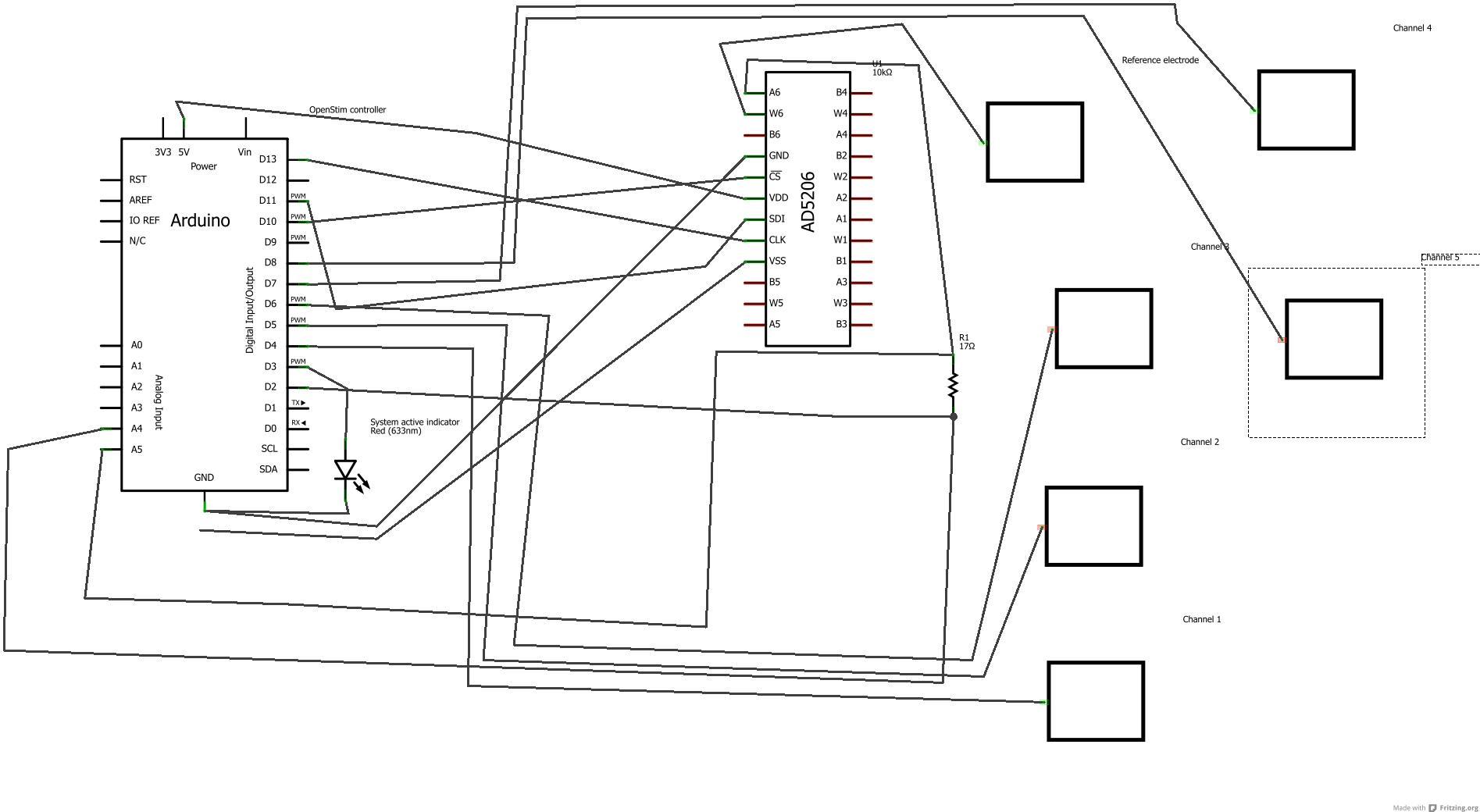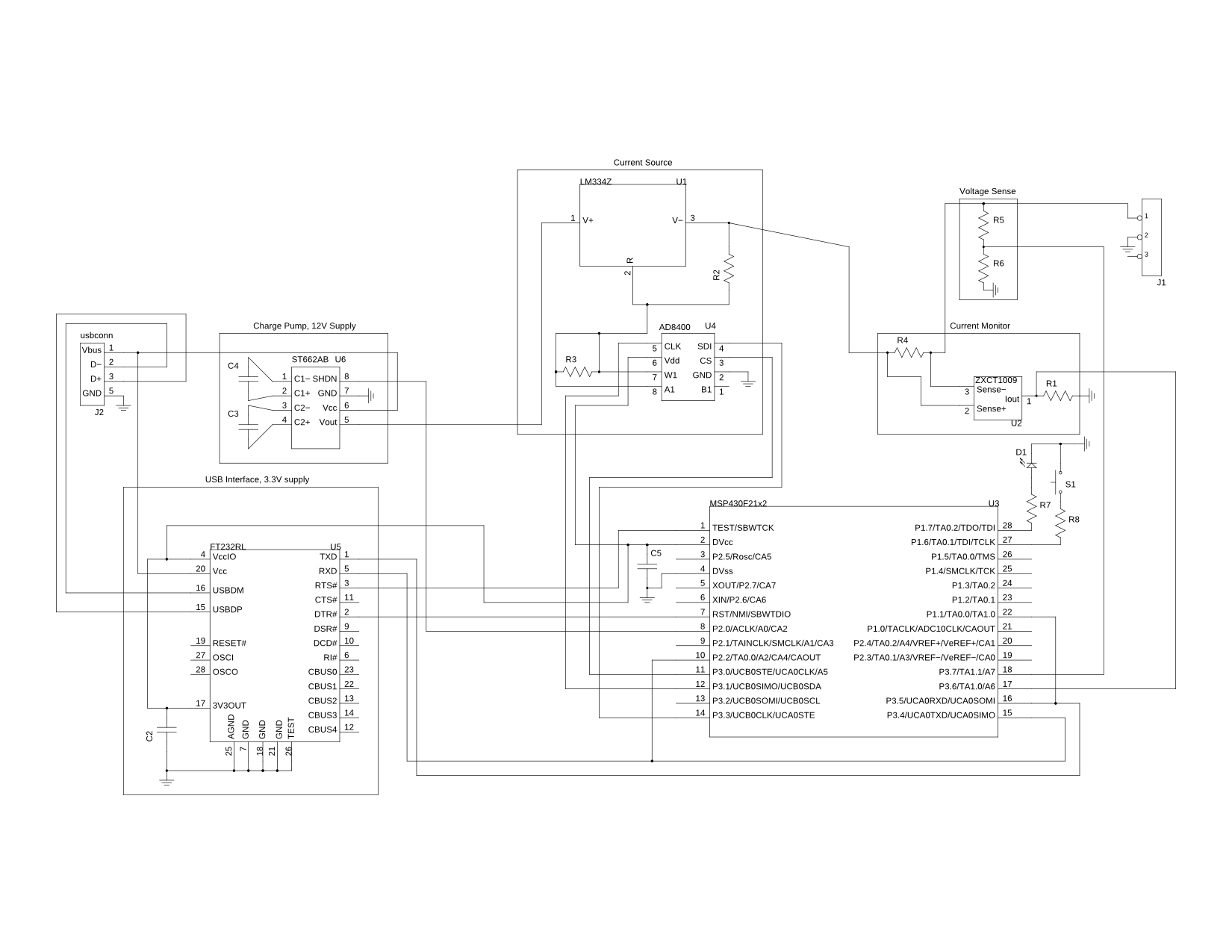Prof. Marom Bikson “Using Computational Models in tDCS Dose” at 5th International Conference on Non-Invasive Brain Stimulation 2013 in Leipzig German (March 19, 2013). High-resolution slides available here (pdf).
Author Archives: John
Treating Depression with tDCS
Brent Williams updates his tDCS YouTube series with an episode on depression.
http://youtu.be/qZKGhTa7c1M
tDCS Part 3 Electrodes and Wires – Brent Williams
http://www.youtube.com/watch?v=4DytCVI5uqs
Insight, a growth project driven by tDCS: Simple DIY TDCS circuit using CRDs

via Insight, a growth project driven by tDCS: Simple DIY TDCS circuit using CRDs.
The Hidden Costs of Cognitive Enhancement | Wired Science
And the link to the full paper. The Mental Cost of Cognitive Enhancement (HatTip ComradeSergey)
Those who had the parietal area involved in numerical cognition stimulated learned the new number system more quickly than those who got sham stimulation, the researchers report today in the Journal of Neuroscience. But at the end of the weeklong study their reaction times were slower when they had to put their newfound knowledge to use to solve a new task that they hadn’t seen during the training sessions. ”They had trouble accessing what they’d learned,” Cohen Kadosh said.
The volunteers who had the prefrontal area involved in learning and memory stimulated showed the opposite pattern. They were slower than the control group to learn the new numerical system, but they performed faster on the new test at the end of the experiment. The bottom line, says Cohen Kadosh, is that stimulating either brain region had both benefits and drawbacks. ”Just like with drugs, there seem to be side effects,” he said.
via The Hidden Costs of Cognitive Enhancement | Wired Science | Wired.com.
See Also: Brain-Boosting Technique Might Help Some Functions While Hurting Others
Michael Weisend – Mind Research Network DIYtDCS Podcast #4
 Michael Weisend PHD. is a principal investigator at The Mind Research Network, MRN.org, and assistant professor of Translational Neuroscience at the University of New Mexico, Albuquerque. Dr. Weisend and his team pioneered a method for determining optimal brain regions for tDCS stimulation using fMRI. Much of Dr. Weisend’s work is focused on cognitive enhancement in healthy subjects for the purpose of reducing the amount of time it takes to master a skill. He shared a full hour of his time and a wealth of tDCS-related information. Download the interview here (zipped mp3). Subscribe in iTunes. (Firefox users- there’s an issue with the html5 audio player. In the meantime you can download the episode or open the page in another browser).
Michael Weisend PHD. is a principal investigator at The Mind Research Network, MRN.org, and assistant professor of Translational Neuroscience at the University of New Mexico, Albuquerque. Dr. Weisend and his team pioneered a method for determining optimal brain regions for tDCS stimulation using fMRI. Much of Dr. Weisend’s work is focused on cognitive enhancement in healthy subjects for the purpose of reducing the amount of time it takes to master a skill. He shared a full hour of his time and a wealth of tDCS-related information. Download the interview here (zipped mp3). Subscribe in iTunes. (Firefox users- there’s an issue with the html5 audio player. In the meantime you can download the episode or open the page in another browser).
Show Notes
The Sally Adee article I discuss. (pdf)
The Through The Wormhole episode mentioned. (YouTube)
Magnetoencephalography
DARPA The Defense Advanced Research Projects Agency
DARWARS Ambush NK is a research program intended to accelerate the development and deployment of military training systems. (wiki) (pdf)
TDCS guided using fMRI significantly accelerates learning to identify concealed objects.
eeg electrodes + gel + wrap.
Transcranial direct current stimulation’s effect on novice versus experienced learning.
iNTIFIC Develops games and training.
pulsed oscillatory electromagnetic fields
tRNS
Fisher Wallace Stimulator.
Perils of tDCS.
F10-anodal, cathodal-opposite upper arm, actually does something.
‘Target search and identification’. What could it be good for the average person?
Dear reader, help me find a way to build a self-experiment that will test my results.
Recalling distant memories?
Anecdotes…
Girl who heard melodies.
Guy who solved a problem he’d been working on.
Age-related memory decline… ‘I can find words now…’
-More verbally fluent as a result of tDCS
-Left Inferior Frontal Gyrus (approx F5-anode, cathode opposite upper arm)
“People do not like it.” Cathodal stimulation of F10
Accelerating non-declarative skill learning.
-Cathode-L-DLPFC, Anode-M1
Grants outstanding to test more of this.
Recruiting the correct brain network to deal with the stimuli at hand for the purpose of successful task completion.
Competing brain networks!
Neural modulation fastest growing area of medicine.
Ethics of tDCS.
Lisa Marshall
Potential for-profit applications?
Conferences: Human Brain Mapping, Seattle June 16-20
Society for Neuroscience San Diego Nov 9-13
tDCS – Building a Resistor Based tDCS Device
Brent Williams of SpeakWisdom (we met him earlier on the blog) has started a YouTube tDCS series. This is his second in the series. This is an excellent overview of the basic components of tDCS, however, Brent does not recommend you actually build
and use a resistor-based device. Brent mentions that upcoming videos will demonstrate how to build a current-regulated device.
http://www.youtube.com/watch?v=d9iId0Aen2g
February 2013 tDCS Papers of Interest
If there’s no link to a pdf, it means the full paper is behind a paywall. If you find a public link to the full paper, please send it along and I’ll update the post. Did I miss anything 😉
Bold: Paper title, linked to Abstract
(pdf): Direct pdf download where available
Italic: ‘Takeaway’ snippet from abstract.
(Bracketed): My thoughts FWIW
Tags:
Transcranial direct current stimulation increases resting state interhemispheric connectivity.
…the tDCS group showed increased DLPFC connectivity to the right hemisphere and decreased DLPFC connectivity to the brain regions around the stimulation site in the left hemisphere. (Lends more credence to the idea of increasing positive effects of tDCS by simultaneously damping down (cathodal) and ramping up (anodal) neuronal activity.)
Tags: theory, learning, enhancement
Transcranial direct current stimulation for treatment of refractory childhood focal epilepsy.
A single session of cathodal tDCS improves epileptic EEG abnormalities for 48 h and is well-tolerated in children.
Tags: epilepsy, children
Brain stimulation modulates the autonomic nervous system, rating of perceived exertion and performance during maximal exercise.
…indicating that the brain plays a crucial role in the exercise performance regulation.
Tags: sports medicine
Evolution of Premotor Cortical Excitability after Cathodal Inhibition of the Primary Motor Cortex: A Sham-Controlled Serial Navigated TMS Study (pdf)
Cathodal inhibition of M1 excitability leads to a compensatory increase of ipsilateral PMC (premotor cortical regions) excitability. (Cathodal tDCS used as a tool to facilitate an experiment)
Tags: theory,
Rethinking Clinical Trials of Transcranial Direct Current Stimulation: Participant and Assessor Blinding Is Inadequate at Intensities of 2mA (pdf) (See also: A big hole in the control? Transcranial direct current stimulation blinding on trial)
Our results suggest that blinding in studies using tDCS at intensities of 2 mA is inadequate. Positive results from such studies should be interpreted with caution.
Tags: theory, sham, blinding,
The effects of cross-hemispheric dorsolateral prefrontal cortex transcranial direct current stimulation (tDCS) on task switching
Task switching, defined as the ability to flexibly switch between tasks in the face of goal shifting, is a central mechanism in cognitive control. …Our findings confirm the notion that involvement of the PFC on task switching depends critically on laterality, implying the existence of different roles for the left hemisphere and the right hemisphere in task switching.
Tags: task switching, theory
The role of timing in the induction of neuromodulation in perceptual learning by transcranial electric stimulation
…tRNS (transcranial random noise stimulation) facilitated task performance only when it was applied during task execution, whereas anodal tDCS induced a larger facilitation if it was applied before task execution. (This study showed tDCS to be more effective when applied prior to training! (i.e. ‘offline’)
Tags: tRNS, offliine, online, training, enhancement, perceptual learning
Modulation of verbal fluency networks by transcranial direct current stimulation (tDCS) in Parkinson’s disease
…left dorsolateral prefrontal cortex (DLPFC) tDCS increased performance on the phonemic fluency task
Tags: Parkinson’s, verbal fluency
Transcranial Electrical Currents to Probe EEG Brain Rhythms and Memory Consolidation during Sleep in Humans (2011) (pdf)
…results demonstrate the suitability of oscillating-tDCS as a tool to analyze functions of endogenous EEG rhythms and underlying endogenous electric fields as well as the interactions between EEG rhythms of different frequencies. (Way over my head at this point but trying to understand it, as Lisa Marshall is frequently mentioned in discussions around tDCS and memory. I’m also trying to build an understanding of EEG.)
Tags: memory consolidation, EEG, theory
(pdf) Random Noise Stimulation Improves Neuroplasticity in Perceptual Learning (2011)
Our results confirmed the efficacy of hf-tRNS over the visual cortex in improving behavioral performance and showed its superiority in comparison to other TES. (tRNS transcranial random noise stimulation, has been showing up more often in relation to studies focused on learning and cognition.)
Tags: tRNS, perceptual learning, neural plasticity,
Focal Modulation of the Primary Motor Cortex in Fibromyalgia Using 4×1-Ring High-Definition Transcranial Direct Current Stimulation (HD-tDCS): Immediate and Delayed Analgesic Effects of Cathodal and Anodal Stimulation
4×1-ring HD-tDCS, a novel noninvasive brain stimulation technique capable of more focal and targeted stimulation, provides significant reduction in overall perceived pain in fibromyalgia patients..
Tags: HD-tDCS, Fibromyalgia, pain health
Transcranial direct current stimulation’s effect on novice versus experienced learning (2011)
TDCS was significantly more effective in enhancing test performance when applied in novice learners than in experienced learners.
Tags: learning, threat detection, anode F8,
Evaluation of sham transcranial direct current stimulation for randomized, placebo-controlled clinical trials.
The tDCS sham condition investigated here may be suitable for placebo-controlled trials keeping subjects blind to treatment conditions. (The protocol for sham tDCS is necessarily evolving.)
Tags: sham,
Tremor Suppression by Rhythmic Transcranial Current Stimulation
With this technique we can achieve almost 50% average reduction in resting tremor amplitude and in so doing form the basis of a closed-loop tremor-suppression therapy that could be extended to other oscillopathies. (tACS transcranial alternating current)
Tags: Parkinsons, tremor, tACS
Is Transcranial Alternating Current Stimulation Effective in Modulating Brain Oscillations? (pdf)
Therefore, the present study does not provide significant evidence for tACS reliably inducing direct modulations of brain oscillations that can influence performance in a visual task.
Tags: tACS, posterior parietal cortex, visual perception
Neuromodulation for Brain Disorders: Challenges and Opportunities (pdf)
This article reviews the state-of-the-art of neuromodulation for brain disorders and discusses the challenges and opportunities available for clinicians and researchers interested in advancing neuromodulation therapies. (Excellent overview of where we’re at with various forms of brain stimulation)
Tags: Neuromodulation, brain stimulation, tDCS, DBS (Deep Brain Stimulation), ICS (intracranial cortical stimulation), TMS (transcranial magnetic stimulation)
Improved proper name recall in aging after electrical stimulation of the anterior temporal lobes (2011) (pdf)
The task was to look at pictures of famous faces or landmarks and verbally recall the associated proper name. Our results show a numerical improvement in face naming after left or right ATL stimulation, but a statistically significant effect only after left-lateralized stimulation.
Tags: name recall, anterior temporal lobes, aging,
Transcranial brain stimulation (not sure this link will work for you pdf)
This book reviews recent advances made in the field of brain stimulation techniques. Moreover NIBS techniques exert their effects on neuronal state through different mechanisms at cellular and functional level.
Tags: NIBS (non-invasive brains stimulation), research overview,
Naming facilitation induced by transcranial direct current stimulation. (2010)
…anodal tDCS of the left DLPFC improves naming performance, speeding up verbal reaction times after the end of the stimulation, whereas cathodal stimulation had no effect.
Tags: learning, left DLPFC,
Consolidation of Human Motor Cortical Neuroplasticity by D-Cycloserine (2004) (pdf)
While anodal tDCS enhances motor cortical excitability, cathodal tDCS diminishes it. Both effects seem to be NMDA receptor dependent. D-CYC selectively potentiated the duration of motor cortical excitability enhancements induced by anodal tDCS.(Again, way over my head, but NMDA receptors comes up frequently in the context of tDCS and neurotransmitters.)
Tags: NMDA receptors, D-Cycloserine, learning, enhancement
Interactions between transcranial direct current stimulation (tDCS) and pharmacological interventions in the Major Depressive Episode: Findings from a naturalistic study. (See also: Electrical Brain Stimulation Plus Drug Fights Depression)
…To investigate the interactions between tDCS and drug therapy …tDCS over the DLPFC acutely improved depressive symptoms.
Tags: depression, Zoloft
Physiological and modeling evidence for focal transcranial electrical brain stimulation in humans: A basis for high-definition tDCS.
We provide direct evidence in humans that TES with a 4 × 1-Ring configuration can activate motor cortex and that current does not substantially spread outside the stimulation area.
Tags: HD-tDCS, electrodes, M1
Transcranial Direct Current Stimulation (tDCS) Reduces Postsurgical Opioid Consumption in Total Knee Arthroplasty (TKA).
…tDCS may be able to reduce post-TKA opioid requirements.
Tags: pain,
Modulating lexical and semantic processing by transcranial direct current stimulation.…(tDCS), which is applied over Wernicke’s area and its right homologue, to influence lexical decisions and semantic priming…
Results showed impaired lexical processing under right anodal/left cathodal stimulation in comparison with sham and left anodal/right cathodal stimulation.
A Treasure Trove of Stimulating Information!
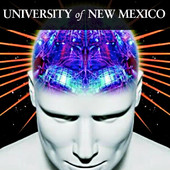 Just found this in iTunesU. Wow! You’ll recognize many of these names if you’re reading the tDCS literature. I’ve only watched the Michael Weisend talks (whom we met earlier on the blog) so far. I have a much better understanding of the difficulty of running a tDCS trial now. There’s a lot that can go wrong. If your protocols aren’t set up just right, your information might be useless. Here’s the web link iTunes Link from which you can download in iTunes. Downloads are quite slow.
Just found this in iTunesU. Wow! You’ll recognize many of these names if you’re reading the tDCS literature. I’ve only watched the Michael Weisend talks (whom we met earlier on the blog) so far. I have a much better understanding of the difficulty of running a tDCS trial now. There’s a lot that can go wrong. If your protocols aren’t set up just right, your information might be useless. Here’s the web link iTunes Link from which you can download in iTunes. Downloads are quite slow.
Introduction to Neurosystems Engineering, Spring 2011 (ECE 595) Neurosystems Engineering is an emerging field at the intersection of Neuroscience, Psychology, and Engineering, and the University of New Mexico is its epicenter.
Course Intro Dr. Gerold Yonas
Course Syllabus Dr. Gerold Yonas
Tools and Techniques in Neuronal Stimulation Dr. Edl Schamiloglu
Basic Principles of Feedback and Control Prof. Chaouki T. Abdallah
Discussing the Course General Approach and Direction Dr. Gerold Yonas
Effects of Direct Current, Non-Invasive Brain Stimulation on Learning Michael Weisend
In the Laboratory Transcranial Direct Current Stimulation (tDCS) Michael Weisend
Posttraumatic Stress Disorder: Roles for Treatment & Prevention (Part I) Dr. Pilar M Sanjuan
Posttraumatic Stress Disorder Roles for Treatment & Prevention (Part II) Dr. Pilar M Sanjuan
Tour of the Mind Research Network Dr. Vince D. Calhoun
Neuroimaging of Intelligence and Creativity (Part I) Dr. Rex E. Jung
Neuroimaging of Intelligence and Creativity (Part II) Dr. Rex E. Jung
Memories and Migraines: Application of tDCS Laura Matzen
Neurochemistry Application in NonInvasive Brain Stimulation Dr. Charles Gasparovic
Non-Invasive Brain Stimulation 1:03:47 Lucas C. Parra
Epilepsy, Autism, and Novel Treatment Strategies Dr. Jeffrey David Lewine
The Emerging Field of Sleep Disorders Medicine Dr. Barry Krakow
Presentation of Class Projects Student
Another DIY tDCS Video
Hard to imagine how he’d have learned enough about tDCS to build a device, but have gotten the (typical) montage so wrong. Placing the cathode over left DLPFC and anode over right orbital is exactly the opposite of what you’ll find in most studies related to both depression and working memory. He doesn’t go into how he’s constructed his electrodes at all. Anecdotally, it is interesting that the reverse montage made him feel angry and depressed.
Weekend tDCS Insights – Chi & Snyder, SpeakWisdom, Carlo Miniussi
Some very excellent tDCS-related documents came to my attention over the weekend. I’m pretty sure I’d looked for at least one of them before, but that it was behind a paywall. I’ll provide links to the pdfs here, but suggest that (as has happened elsewhere on the blog) pdf links frequently go bad so ‘get em while they’re hot’.
Brain stimulation enables the solution of an inherently difficult problem (pdf)
This is the paper by Alan Snyder and Richard Chi that is frequently referenced in ‘unlock your inner savant’ articles on various pop-sci sites. (See also) Spoiler alert! Gives the answer to the ‘9 dot’ problem and once you’ve seen it it will be impossible to discover how ‘savant-like’ you are (at least according to this test).
…we applied cathodal tDCS (1.6mA) at the left anterior temporal lobe (ATL) together with anodal tDCS at the right ATL for approximately 10 min… None of the 22 participants in the main experiment solved the nine-dot problem before stimulation. But with 10 min of right lat- eralizing transcranial direct current stimulation (tDCS), we found that more than 40% of participants could do so.
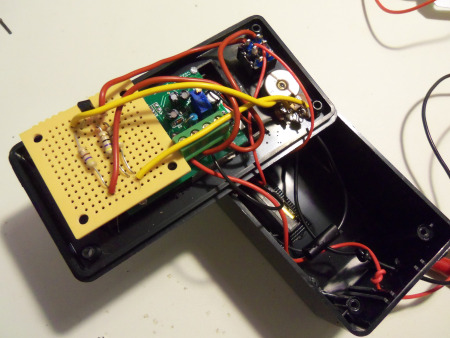 Dr. Brent Williams, at his SpeakWisdom blog, published another excellent tDCS post updating his DIY device, and adding a .doc that outlines his recommended (For Discussion) protocols for depression, ‘Savant Learning’, memorization, and chronic pain.
Dr. Brent Williams, at his SpeakWisdom blog, published another excellent tDCS post updating his DIY device, and adding a .doc that outlines his recommended (For Discussion) protocols for depression, ‘Savant Learning’, memorization, and chronic pain.
His protocol describes directions for use with either his ‘User-Built tDCS Research Device’, or the ActivaDose II.
Transcranial Magnetic and Electric Stimulation in Perception and Cognition Research (pdf)
This is a fascinating paper (Carlo Miniussi et al) that brings us up to date (2012) on applications of tDCS, TMS tACS (transcranial alternating current), and tRNS (transcranial random noise stimulation), especially in relation to cognition and learning. What really caught my eye was this entry about tRNS…
tRNS consists of the application of a random electrical oscillation spectrum over the cortex. tRNS can be applied at different frequency band ranges over the entire spectrum from 0.1 to 640 Hz…They applied tRNS to the visual cortices of healthy subjects and observed a significant improvement in the performance of healthy subjects in a visual perceptual learning task. This improvement was significantly higher than the improvement obtained with anodal tDCS…
And that folks, is how a weekend disappears down the rabbit hole!
Marom Bikson of Soterix Medical and CUNY – DIY tDCS Podcast Episode #3
Marom Bikson is CEO of Soterix Medical and Associate Professor at City College of New York in the Department of Biomedical Engineering. Marom is a distinguished tDCS scientist and prominent in the development of HD-tDCS. Download the interview here (zipped mp3). (Firefox users- there is an audio player here, but it’s displaying intermittently. Trying to track down the issue. In the meantime you can download the episode or open the page in another browser).
(We got a good forty minutes of interview in before the Skype gremlins caught up with us. I had to cobble an ending together.)
Show Notes:
Post-Doc, Neurophysiology Unit, University of Birmingham Medical School, U.K., 2003
Ph.D., Biomedical Engineering, Case Western Reserve University Cleveland, OH, 2000
B.S., Biomedical Engineering (EE Concentration), Johns Hopkins University, Baltimore, MD, 1995
Introduction to Transcranial Direct Current Stimulation (tDCS) in Neuropsychiatric Research
5th International Conference on Non-invasive Brain Stimulation 2013
Instrumentation – making medical gizmos, process.
IRB- Institutional Review Board
IRB at the FDA
Small Business Technology Transfer STTR grant.
Soterix partners
Abhishek Datta CTO,
Lucas Parra
Bootstrapped at this point.
Difficulty in engineering medical devices is in designing for the anomalous cases- how that 1 in 999 times situation could go wrong.
Clinical trials. Depression, (Colleen Loo, Blackdog Institute), pain, stroke, epilepsy clinical trials ongoing.
Customizing technologies to match needs of particular clinical situations.
Soterix developed software designed for clinicians.
HDTargeting
HDExplore
Modeling current flow through the head.
Perhaps depression studies are closest to FDA qualification for tDCS?
(Prediction is very hard, especially about the future – Yogi Berra.)
A device (NorDoc Smartstim) that can go to 4mA is being used in a smoking cessation trial? (Trial info indicates 2mA current dose.)
FDA tDCS approval would be device-specific at first. But would open the door to ‘me too’ mechanism, FDA 510(k)
HD tDCS can have multiple cathodes and or multiple anodes. An array of 4 small anodes splitting 2mA, for example (.5 mA each electrode), can function as an anodal ‘virtual pad’. Assumes cathode somewhere else on the body).
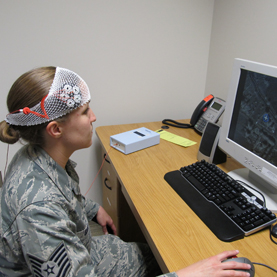
Image By Richard McKinley USAF
Tolerability is how tolerable in terms of side effects a medication is.
Transcutaneous Spinal Direct Current Stimulation Example tsDCS paper.
A Theory of tDCS (“Gross oversimplification”) As positive current flows into the cortex it passes neurons.
Because of the nature of neurons, this positive current depolarizes somas (cell’s body), increasing excitability, thereby increasing the functionality & plasticity of that region (hypothesis… “We really don’t know.”). Under the cathode, somas (cells) are being hyper-polarized – excitabilty decreases.
A synapse is a structure that permits a neuron (or nerve cell) to pass an electrical or chemical signal to another cell.
Pyramidal neuron
Titration, also known as titrimetry, is a common laboratory method of quantitative chemical analysis that is used to determine the unknown concentration of an identified analyte.
TES Transcranial Electric Stimulation
“transcranial electrical stimulation” Merton and Morton 1980
“Priming the network in conjunction with applying tDCS makes a lot of sense, as a way to make the tDCS to do what you want.” (Co-priming – The idea that one would initiate an activity first, and THEN add tDCS.)
DARPA supported accelerated learning.
Memory consolidation.
Lisa Marshall
DIY tDCS community and building medical devices. Redundancy.
tDCS implies proven, vetted protocols, that have been used in clinical trials.
Thanks Marom!
Recent tDCS Papers of Interest
- Acute working memory improvement after tDCS in antidepressant-free patients with Major Depressive Disorder. All effect sizes were large. In other words, one session of tDCS acutely enhanced WM in depressed subjects…(Paywall)
- Neurobiological Effects of Transcranial Direct Current Stimulation: A Review The purpose of this systematic review is to summarize the current knowledge regarding the neurobiological mechanisms involved in the effects of tDCS. (pdf)
- Modulating Human Procedural Learning by Cerebellar Transcranial Direct Current Stimulation. Our finding that anodal cerebellar tDCS improves an implicit learning type essential to the development of several motor skills or cognitive activity suggests that the cerebellum has a critical role in procedural learning. (Paywall)
- Neuroenhancement of the aging brain: Restoring skill acquisition in old subjects. These results suggest noninvasive brain stimulation as a promising and safe tool to potentially assist functional independence of aged individuals in daily life. (Paywall)
- Examining transcranial direct-current stimulation (tDCS) as a treatment for hallucinations in schizophrenia. Although this study is limited by the small sample size, the results show promise for treating refractory auditory verbal hallucinations and other selected manifestations of schizophrenia. (Paywall)
- Modulation of training by single-session transcranial direct current stimulation to the intact motor cortex enhances motor skill acquisition of the paretic hand.These results indicate that tDCS is a promising tool to improve not only motor behavior, but also procedural learning. (Paywall)
- Interactions between transcranial direct current stimulation (tDCS) and pharmacological interventions in the Major Depressive Episode: Findings from a naturalistic study. tDCS over the DLPFC acutely improved depressive symptoms. Besides the inherent limitations of our naturalistic design, our results suggest that tDCS effects might vary according to prior pharmacological treatment… (Paywall)
- Amelioration of Cognitive Control in Depression by Transcranial Direct Current Stimulation. Deficient cognitive control over emotional distraction is a central characteristic of major depressive disorder (MDD). The present study demonstrates that anodal tDCS applied to the left dlPFC improves deficient cognitive control in MDD. (Paywall)
- Comparing immediate transient tinnitus suppression using tACS and tDCS: a placebo-controlled study. Our main result was that bifrontal tDCS modulates tinnitus annoyance and tinnitus loudness… (Paywall)
- Review of transcranial direct current stimulation in poststroke recovery. In this review, we summarize characteristics of tDCS (method of stimulation, safety profile, and mechanism) and its application in the treatment of various stroke-related deficits… (Paywall)
- Enhancing vigilance in operators with prefrontal cortex transcranial direct current stimulation (tDCS). These findings indicate that tDCS may be well-suited to mitigate performance degradation in work settings requiring sustained attention or as a possible treatment for neurological or psychiatric disorders involving sustained attention. (Paywall)
Dr. Jim Fugedy of the Brain Stimulation Clinic in Atlanta – DIY tDCS Podcast #2
[Apologies for audio quality. It won’t happen again.]
Dr. Jim Fugedy runs the Brain Stimulation Clinic, in Atlanta, GA, and has been treating patients using tDCS since 2007. Download the interview here (zipped mp3).
The Brain Stimulation Clinic in Atlanta is the destination for memory and learning enhancement and treatment-resistant patients who suffer from chronic pain, fibromyalgia, migraine headaches, CRPS, depression and tinnitus. Transcranial direct current stimulation (tDCS) therapy is provided in a pleasant, relaxing environment. Instruction, training and supervision for home use is also available for select patients.
Show Notes:
Jim is an anesthesiologist.
The study Jim refers to regarding Felipe Fregni & fibromyalgia:
A randomized, sham-controlled, proof of principle study of transcranial direct current stimulation for the treatment of pain in fibromyalgia (full pdf)
tDCS for treatment of fibromyalgia is not certified – it’s ‘off label’
Device is certified, but not for tDCS = no insurance code, can’t be billed to insurance
20 minute treatment for 5 days.
For fibromyalgia – reduces pain, improves issues – fatigue, compromised mental function
2″ electrodes
(ActivaDose ii Update 3/16 now available as complete tDCS kit through Caputron Medical, use voucher code ‘diytdcs’ for generous discount.)
Most benefit… chronic depression, treatment protocol based on Colleen Loo, Black Dog Institute 6 weeks, follow up maintenance. Up to 8 weeks of treatment + 1-2 treatments follow up maintenance. Daily 20 minute sessions
Can be treated at the clinic for 1-2 weeks. Or home treatment package.
“To treat depression, I place the anode over the left dlpfc (left dorsolateral prefrontal cortex) and the cathode over the contralateral supraorbital area. I have tried positioning the cathode over the contralateral dlpfc and extracephalically (opposite shoulder or upper arm), but the contralateral supraorbital locations provides the most robust effect.” (Correspondence)
Pain montage 2mA, anode M1 & cathode contralateral supra-orbital area

anode at the right primary motor cortex (M1)–cathode on the left supra-orbital From: http://www.sciencedirect.com/science/article/pii/S1053811907000055
For chronic pain, the M1 is the most used area and that’s almost always my first choice. But you can use the cathode over the somatosensory (S1) cortex, to down-regulate the patient’s perception of pain.
And you can also stimulate the Dorsalateral prefrontal cortex which is involved in the emotional component of pain.
Looking at stimulating right dorsalateral prefrontal cortex to attenuate anxiety.
… it may be a location
for the non-pharmaceutical treatment for ADD.
Office visit $150.
Home use treatment package $2400 includes in-office evaluation and training, ActivaDose ii device, electrodes, and unlimited follow-up via visit, phone, skype…
Only side effect Jim has seen is skin burn (but easily avoided with sponge electrodes).
(Patient with skin burns who’d been treated by a doctor using electroencephalogram (EEG) electrodes.)
Tinnitus responds well, though temporarily, to tDCS
Anode, right dorsalateral prefrontal cortex, cortex opposite supra-orbital
Harvard one day course on how to treat with tDCS. Taught 3-4 times a year.
Contrast with approved Electromagnetic treatment for depression (I think he’s referring to TMS transcranial magnetic stimulation here) A 6 week 30 treatment protocol costs between $10-15,000. Affects last about 6 months. And even though it’s certified, it’s not covered by insurance.
…”in the 12 years that it’s been used there have been no side effects reported other than skin (irritations).
“You know we hear stories about Canadians having to wait for surgery. But in the United States, if you don’t have the money and you don’t have insurance, you don’t have to worry about waiting, you won’t get the surgery.”
You can reach Jim at: doctorfugedy [theAtSignHere] transcranialbrainstimulation.com
Thanks Jim!
The Open tDCS Project
Update 7/2/14 First of all, thanks Z for pointing out the two schematics that are now considered dangerous, in the sense that they could lead to an initial ‘zap’ and possible burn.
As I’ve mentioned earlier, I myself am not an electronics person. The notion of ‘Open tDCS’ was to develop an excellent device through Upverter (or similar online platform), that anyone could then order directly from a Chinese manufacturer (thereby circumnavigating any regulation issues etc).
We have yet to find an engineer to lead and build the design team and my thoughts about why are simply that people are too busy, or that they see a possible financial gain for their own device somewhere down the road. Considering the original post/Upverter account is a year and a half old, it seems unlikely we’ll find someone, but you never know!
——————————
Upverter is an online platform that allows for electronics to be designed, parted, and built. As I understand it, once the design is fixed, you shop for parts – inside of Upverter, and then submit your project (to Upverter’s Chinese partners) to be built. I’d mentioned Upverter on the tDCS subReddit a few times. I was hoping to pique the curiosity of the engineer types that had designed and built their own tDCS devices… Crowdsource the design, and then anyone can order one!
What happened was I got an email from Eric Evenchick, a ‘customer success / hardware engineer person’ at Upverter! Eric had seen my post and written to help. He waived the team fee, set up the project and ported the OpenStim Arduino-based tDCS design, by ohsnapitsnathan (Reddit handle).
I hope I didn’t step on any toes by collecting these schematics to one place. I wanted engineers to be able to see quickly how other designers have thought about building their devices. If you’re an engineer type interested in tDCS please join our Upverter team.
It feels silly to put it this way, when the very nature of Open implies extreme democracy, but here goes… Here’s my vision of an Open tDCS project.
- Build an Upverter team
- Design, part, and prototype a minimum viable tDCS device
- Working with an online ‘cognitive test’ site, build a protocol for measuring the effectiveness of tDCS
Later on we could develop a multi-channel device, and maybe this is just a fantasy, but if it could interact with the internet, researchers could design tests and collect data non-locally. How cool would that be?
The rest of this post will attempt to collect in one place the various schematics I’ve seen for DIY tDCS devices.
I called this one Imgur earlier on the blog. It comes from 55tfg7879fe42e345 (Reddit handle)
brmlab our Czech friends
The Focus device.
And then the more advanced, programmable tDCS devices. OpenStim
Open Stim Multi-Channel
Shawn Nock Version 2
If you know of a schematic I missed please let me know, and even if you’re not an engineer, consider joining Upverter and ‘Following’ our project.


